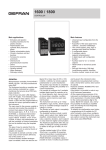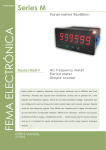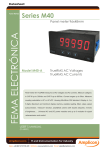Download USER'S MANUAL !
Transcript
2308 MULTIZONE INDICATOR / ALARM UNIT USER’S MANUAL SOFTWARE VERSION 4.x code 80330B / Edition 08 - 06/09 2 • TECHNICAL SPECIFICATIONS 1 • INSTALLATION • Dimensions and cut-out; panel mounting 108 Resolution 4000 pt Accuracy 0.2% f.s. ±1 digit for linear inputs 0.5% f.s. ±1 digit for TC, RTD, mVac inputs Acquisition speed Thermocouples 160msec per channel J, K, S, R, T Resistance Thermometer RTD Pt100 2-wires RTD Pt100 3-wires Power supply 100...240Vac/dc ±10% 11...27Vac/dc ±10% 50/60Hz, 10VA Relay output NC/NO selectable with jumpers (5A/220Vac cosϕ = 1) (1,5A cosϕ = 0,2) 115 96 48 Logic output 70 44,5 25V/15mA max - “Watch-dog” protection circuit for instrument reset in case of interference - 3 SW protection levels - jumper to enable access to calibration from panel keys 0...50°C 8-bit microprocessor Protections 92 Work temperature Function 157 CE MARKING: The instrument conforms to the European Directives 2004/108/CE and ! 2006/95/CE with reference to the generic standards: EN 61000-6-2 (immunity in industrial environment) EN 61000-6-3 (emission in residential environment) EN 61010-1 (safety). For correct and safe installation, follow the instructions and observe the warnings contained in this manual. 10 MAINTENANCE: Repairs must be done only by trained and specialized personnel. Cut power to the device before accessing internal parts. Do not clean the case with hydrocarbon-based solvents (Petrol, Trichlorethylene, etc.). Use of these solvents can reduce the mechanical reliability of the device. Use a cloth dampened in ethyl alcohol or water to clean the external plastic case. SERVICE: GEFRAN has a service department. The warranty excludes defects caused by any use not conforming to these instructions EMC conformity has been tested with the following connections FUNCTION Power supply cable Relay output cable Digital communication wires TC input Pt100 input Panel mounting: To fix the unit, insert the brackets provided into the seats on either side of the case. To mount two or more units side by side, respect the cut-out dimensions shown in the drawing. max.6,9 Low-signal line Feeder and output line A 6...7 With fork terminal; with tinned wire; with ring terminal 80330B_MHW_2308_0609_ENG D B A SERIAL B INPUTS C MD81 EXPANSION D OUTPUTS /RELAYS E FEED E + Channel STANDARD VERSION WITH SCREW TERMINAL max.6,9 LENGTH 1m 3,5 m 3,5 m 5m 3m 4 • SUGGESTED CONNECTIONS 22 21 20 19 18 17 16 15 14 13 12 1 2 3 4 5 6 7 8 9 10 11 Channel 3 • TERMINALS CABLE TYPE 1 mm2 1 mm2 0,35 mm2 0,8 mm2 compensated 1 mm2 C 1 5 • DESCRIPTION OF FACEPLATE Auxiliary display Indication of displayed channel Main display Displays the variables for the 8 channels Signal: alarms 1 and 2 relays energized REM serial communication signals, configuration for 8 inputs 100mVac Function button Used to select the various channels when the instrument operates in manual and to end the configuration and calibration procedures at any time “Calibration” button Gives access to various steps of instrument calibration procedure Plate showing units of measurement “Configuration” button Gives access to various steps of normal (alarm setting) and complete calibration procedure for the instrument “Raise” and “Lower” buttons Lets you raise (lower) any numerical value or choice of optional. •• Raising (lowering) speed is proportional to duration of pressing time. •• The procedure is not cyclical; i.e., once the maximum (minimum) value for the setting is reached, the raise (lower) function is blocked even if the button remains pushed. “Man/Auto” channel scan button Switches operation from manual to automatic and vice versa. In manual, channel scanning is done with the “Function” button. In automatic (decimal point of auxiliary display ON), scanning is automatic. •• Press the key at any point of the configuration procedures to display the software version. Small display: “U”; Large display: n version. This display persists until the key is pressed again. 6 • CONNECTIONS • Inputs (See HW configuration) Available thermocouples: J, K, S, R,T • TC In + 1 - Observe polarities - For extensions, use the correct compensating cable for the type of TC used - • RTD Pt100 2-wires Use wires of adequate diameter (min. 1,5mm2) In 1 • RTD Pt100 3-wires In In • Serial line 18 21 Connection RS485 15 Rx + 14 20 Standard: 100...240Vac/dc ±10% A (Data -) 19 18 NO/NC 13 ~ 12 ~ +IN5 +IN6 +IN7 +IN8 D CK 15 14 13 12 3 4 5 6 7 8 9 10 11 + +IN4 16 - +IN3 2 - 17 + +IN2 1 Rx P O W E R S U P P L Y O U T 1 M D 8 1 NO / NC O U T 2 NO / NC S E R I A L L I N E Potentiometer ≥ 1KOhm 18 - +IN1 19 + 21 + 22 Tx Scale in direct voltage 0…20, 0…50, 0…10 mV, 0…10V Scale in direct current 0…20, 4…20 mA 20 C All. 1 + Optional: 11...27Vac/dc ±10% Rx Use wires of adequate diameter (min. 1 mm2) The 3-wire resistors take up 2 inputs: the actual input must be odd (1-3-5-7), and the next channel, even, for the third wire. NO/NC • Power Supply A (Data +) Tx NOTES: For a 15m cable with 1.5 mm2 section, the error is approximately 1°C. C All. 2 + + - 22 Max In With 10V power only (reference to S6 Power jumper) INPUTS 1 Min 0...100mVac • Vac ~ Common 2 19 16 - • Potentiometer 20 Resistance in series to the diode is 1KΩ; in series to the transistor collector is 100Ω 17 COMMON GND 1 Tx + V In 21 Connection Parallel Current Loop 1 • Linear • Alarm outputs Contact capacity 5A/220Vac For logic output 24V/15Ma In 1 ATTENTION: all 8 inputs must be in mVac 1 2 3 4 5 GND Channel 1 input Channel 2 input Channel 3 input Channel 4 input 6 7 8 9 • MD81 (see paragraph 10) Channel 5 input Channel 6 input Channel 7 input The MD81 unit must be placed near the instrument (max 20cm) 11 CK 10 D Channel 7 input 1 GND 80330B_MHW_2308_0609_ENG 7 • HARDWARE CONFIGURATION Power board Sensor / transmitter power (fastons 1-22) S0 S6 S1 22 S6 15V S6 10V S3 S2 Alarm 1 (fastons 14-15) NO Contact S2 Digital communication connection (Rx) S1 Parallel connection S1 Serial connection S2 NC Contact Alarm 2 (faston 16-17) S3 12 NC Contact S3 NO Contact Terminal 22 polarization S0 S0 Terminal 22 = positive sensor feed A Terminal 22 = negative sensor feed B JUMPER A CPU board SV / S ST / N / SI TC, RTD, Vdc, Pot.. mA Inputs Vac Inputs S15A 11 S19 Jumper A S9 S15B S19 Temperature (°F - °C) 1 Access to calibration S9 Serial line preset for Parallel / Serial connection (TX) S18 °C S17 Disabled S16 Serial connection S18 °F S17 Enabled S16 Parallel connection SVx Potenz.; 0...10Vdc JUMPER SV/S Input type: single channel Sv S Sx channel 1 TC; RTD; mV; mA; Vac channel 8 JUMPER ST / N / SI Input type: single channel ST N SI channel 1 STx TC Nx Vac/Vdc; RTD; Pot. SIx 0...20mA 4...20mA channel 8 8 • SOFTWARE CONFIGURATION 8a • Display F Display channel 1 DISPLAY CHANNEL 2 ....... DISPLAY LAST CHANNEL SELECTED 8b • Alarm setting If alarm is normal Display CFG CFG F Setting alarm limit Display Select alarm no. in range 1…10 with keys " ∆ ∇" Channels selected (x - y) If alarm = AND/OR function of alarms from x to y (ex. 3-5) 80330B_MHW_2308_0609_ENG 3 8c • Configuration Serial communication transmission speed Display Press CFG for 10 sec. CFG Software protection Prot Configuration 0 1 2 3 if Enabled Enabled Disabled Disabled Alarm setting Enabled Disabled Enabled Disabled b 0 1 2 3 4 5 6 7 8 9 10 11 12 13 14 15 Baud rate 1200 bit/sec 2400 bit/sec 4800 bit/sec 9600 bit/sec 1200 bit/sec 2400 bit/sec 4800 bit/sec 9600 bit/sec 1200 bit/sec 2400 bit/sec 4800 bit/sec 9600 bit/sec 1200 bit/sec 2400 bit/sec 4800 bit/sec 9600 bit/sec Protocol Cencal Cencal Cencal Cencal Modbus Modbus Modbus Modbus Modbus Modbus Modbus Modbus Modbus Modbus Modbus Modbus =0 Parity none none none none even even even even odd odd odd odd if with keys " ∆ ∇" Access to configuration phase Set 0 to go to channel configuration; set 1…10 to go to alarm configuration C = 31 or 32 (AND/OR function) J K R S T Pt100/2 Pt100/2 Pt100/3 Pt100/3 0...800°C / 32...1472°F 0...1300°C / 32...2372°F 0...1600°C / 32...2912°F 0...1760°C / 32...2912°F -100...400°C / -148...752°F 0...20mA 4...20mA 100m Vac (only HW config.) 0...20mV 0...50mV 0...100mV 0...10V -200...400°C / -328...752°F -99,9...100,0°C / -99,9...212,0°F -200...400°C / -328...752°F -99,9...100,0°C / -99,9...212,0°F Potentiometer No. first alarm Setting decimal point 0 0 LINEARS Press the “Raise” and “Lower” keys to move the decimal point Fixed decimal Setting alarm hysteresis value t>F Selection of event type for alarm filter 1,2Hz 0= filter ON 1= filter OFF Setting value of alarm limit (*) 1 Digital filter alarm 3...10 Fixed 1...8 channel Hyst 1 ÷ 2 = -999...9999 Hyst 3 ÷ 10 = -128...127 TC/RTD Setting minimum LINEARS -999...9999 Scale range scale value TC/RTD Setting maximum LINEARS -999...9999 Scale range scale value C = 1...30 (normal alarm) Absolute = scale range Deviation = -999…9999 No. last alarm 1 AND (C = 31) Alarm active if all alarms are active (ON) Alarm active if at least 1 alarm is deactivated (OFF) OR (C = 32) Alarm active if at least 1 alarm is active (ON) Alarm active if all alarms are deactivated (OFF) CFG All alarms Alarm not engaged Alarm assigned to channel 1…8; alarm setpoint is absolute Alarms 1 and 2 only 9 Alarm assigned to all channels; alarm setpoint is absolute; alarm is active if all channels are in alarm state 10 Alarm assigned to all channels; alarm setpoint is absolute; alarm is active if at least one channel is in alarm state 11...18 Deviation alarm assigned to channel 1…8; alarm setpoint relates to setpoint of alarm (3…10) assigned to channel 19 Alarm assigned to all channels; for each channel, alarm setpoint relates to setpoint of alarm (3…10) assigned to channel; alarm is active if all channels are in alarm state 20 Alarm assigned to all channels; for each channel, alarm setpoint relates to setpoint of alarm (3…10) assigned to channel; alarm is active if at least one channel is in alarm state 21...28 Alarm assigned to channel 1…8; alarm setpoint defines a symmetrical event window around the setpoint of alarm (3…10) assigned to channel 29 Alarm assigned to all channels; for each channel, alarm setpoint defines a symmetrical event window around the setpoint of alarm (3…10) assigned to channel; alarm is active if all channels are in alarm state 30 Alarm assigned to all channels; for each channel, alarm setpoint defines a symmetrical event window around the setpoint of alarm (3…10) assigned to channel; alarm is active if at least one channel is in alarm state 31 AND function for multiple alarms (3…10) 32 OR function for multiple alarms (3…10) 0 1...8 Setting (alarm 1 and 2) and display (alarm 3…10) of channel assigned to alarm Selection of input type F Set no. of channels (1…8) actually used (+8 to enable automatic scanning) Select a no. in range 0…9999 = 1...10 From 1 to last channel selected 0= return to alarm configuration phase Selection of channel 0 1 2 3 4 5 6 7 8 9 10 11 12 13 14 15 16 Interface CL/485 CL/485 485 485 485 485 485 485 485 485 485 485 485 485 485 485 Alarm configuration Input configuration No. of channels actually used Instrument code for digital communication Setting alarm event type 0 1 0 1 0 1 Absolute alarms Alarm active above limit Alarm active below limit Deviation alarms Alarm active above (limit + absolute) Alarm active below (limit + absolute) Symmetrical alarms Alarm active outside interval Alarm active inside interval Note: if U=1, alarm tripping under channel conditions OR and AND is reversed from 9 to 30. (*) For symmetrical alarms with negative hysteresis, hysteresis is placed inside the window, whereas with positive hysteresis it is placed outside. The minimum alarm (positive hysteresis, type 1 event) is automatically excluded in the startup phase until the input variable has exceeded the set limit. Move from one configuration phase to another by pressing the CFG key; press the F key to go to display. 8d • Calibration Display CAL If jumper S17 is present (see para. 7) Selection of channel to be calibrated (1…8) Display type of input to be calibrated No. of selected channel No. of selected channel (see para. 8c) Display room temperature setting * for TC only With a calibrator or generator, transmit a signal equal to min. scale value to the corresponding input. For input 4…20mA, give a minimum value of 0mA. Transmit a signal equal to max. scale value to the corresponding input of the instrument. ATTENTION: the instrument is supplied calibrated; any additional calibration must be made by a trained technician equipped with the necessary devices. The procedure is irreversible. 4 80330B_MHW_2308_0609_ENG 9 • CONNECTION EXAMPLES Connection examples 1 22 21 20 19 18 17 16 15 14 13 12 1 2 3 4 5 6 7 8 9 10 11 I N1 I N2 I N3 I N4 I N5 I N6 I N7 I N8 +Tc +Tc +Tc J K S +10V +4 / 20 mA +50 mV + Transmitter. - Input no. Input type HW configuration jumpers closed (on) 1 Potentiometer SV1-N1 2 Potentiometer SV2-N2 3 Thermocouple J S3-ST3 4 Thermocouple K S4-ST4 5 Thermocouple S S5-ST5 6 0...10V SV6-N6 7 4...20mA S7-SI7 8 0...50mV S8-N8 Reference for inputs in mV and TC is terminal 1 (common to all inputs) S11 - S12 - S14 - S15B - S19 = ON SW configuration t = input type 16 16 0 1 3 11 6 9 Connection examples 2 22 21 20 19 18 17 16 15 14 13 12 1 2 3 4 5 6 7 8 9 10 11 I N1 I N2 I N3 I N4 I N5 I N6 I N7 I N8 +50 mV +4 / 20 mA +Tc +Tc +Tc J K S V ext + + Transmitter. RTD 3 F - Input no. RTD 2 F HW configuration jumpers closed (on) 1 RTD 3-wires S1-N1 2 (3rd wires RTD) S2-N2 3 RTD 2-wires S3-N3 4 0...50mV S4-N4 5 4...20mA S5-SI5 6 Thermocouple J S6-NT6 7 Thermocouple K S7-ST7 8 Thermocouple S S8-ST8 Reference for inputs in mV and TC is terminal 1 (common to all inputs) S11 - S12 - S14 - S15B - S19 = ON 80330B_MHW_2308_0609_ENG Input type SW configuration t = input type 14 (15) -1 12 (13) 9 6 0 1 3 5 10 • ACCESSORIES • MD8 - Expansion module for 8 alarm relays - Order code MD8 Version For model 2300 0 For models 3500/4500 - 2308 1 Output Relay R0* Static D2 Power supply 11...27Vac/dc ±10% 0 100...240Vac/dc ±10% 1 * Standard version CONNECTIONS OUT 9 NO / NC (-) (+) (+) (-) OUT 8 NO / NC C (-) OUT 10 (+) (-) NO (+) NC OUT 7 NO / NC POWER SUPPLY 22 21 20 19 18 17 16 15 14 13 12 22 21 20 19 18 17 16 15 14 13 12 GEFRAN 2308 1 2 3 4 5 6 7 8 9 10 GEFRAN MD8-1 11 1 2 3 4 5 6 7 8 9 10 11 (-) D (+) CK (-) GND OUT 3 NO / NC (+) (+) (-) (-) (+) OUT 6 NO / NC OUT 5 NO / NC OUT 4 NO / NC TECHNICAL DATA Signals 8 red LEDs turn on with relays energized and flash when alarm limits are set on master instrument Red power on LED Outputs Relay outputs with NA or NC contact selectable with jumpers. Contact capacity 5A/220Vac to cosϕ=1 (1.5A to cosϕ=0.2). Protection with MOV 275V spark suppressor Alternate: logic outputs type D2 PNP 24V/15mA max Power supply Standard 100...240Vac/dc - 11...27Vac/dc 6 Absorbed power: 4VA. Working temperature: 0÷50°C Case - Policarbonato autoestinguente V0; dimensioni frontali 96x48; profondità incasso 152mm; foratura 92x45mm. - Fissaggio a retroquadro con staffette in dotazione. - Estraibilità frontale parte elettronica. - Disponibilità di calotte frontali con guarnizioni fino ad un grado massimo di protezione pari a IP65. Electrical connections - Split terminals accept one 6.35 mm faston or two 2.8 mm fastons - Terminals completely recessed for accident prevention Weight: approx. 600 gr 80330B_MHW_2308_0609_ENG 11 • ACCESSORIES Polycarbonate cap Protection level IP54 (frame) grey / (door) transparent For instruments size 96x96mm (1/4 DIN) Order code 51065 For instruments size 48x96mm (1/8 DIN) Order code 51066 Polycarbonate cap with rubber gasket Protection level IP65 (frame) grey / (door) transparent For instruments size 96x96mm (1/4 DIN) Order code 51064 For instruments size 48x96mm (1/8 DIN) Order code 51067 Dust-proof polycarbonate cap (transparent) Mod. CFA110 48x48mm (1/16 DIN) - order code 51060 Mod. CFA120 48x96mm (1/8 DIN) - order code 51061 Mod. CFA220 96x96mm (1/4 DIN) - order code 51062 Silicon rubber protection Protection level IP65 (transparent) 48x48mm (1/16 DIN) - order code 51183 48x96mm (1/8 DIN) - order code 51185 96x96mm (1/4 DIN) - order code 51186 Instrument hole plug in self-extinguishing polycarbonate V0 (grey) Mod. Q48, for hole 45x45mm for instruments size 48x48mm (1/16 DIN) - order code 51177 Mod. Q94, for hole 45x93mm for instruments size 48x96mm (1/8 DIN) - order code 51178 Mod. Q96, for hole 93x93mm for instruments size 96x96mm (1/4 DIN) - order code 51179 80330B_MHW_2308_0609_ENG 7 ORDER CODE 2308 DIGITAL COMMUNICATION STANDARD CONFIGURATION Hardware and Software Serial Current Loop 1* Serial RS485 2 CH1...CH8 - Thermocouple inputs J 0...800°C Alarms - Setting 500 - Hysteresis -1 - Relay energized above set limit - NO relay contacts ALARM OUTPUT Relay R0* Static D2 Power output for 10VDC external sensor Enable automatic channel scan POWER SUPPLY 100...240Vac/dc 1* Configuration and setting enabled 11...27Vac/dc 0 Calibration disabled * Positions marked with asterisk indicate standard model Parallel connection for serial line Please, contact GEFRAN sales people for the codes availability. • WARNINGS ! WARNING: this symbol indicates danger. It is placed near the power supply circuit and near high-voltage relay contacts. Read the following warnings before installing, connecting or using the device: • follow instructions precisely when connecting the device. • always use cables that are suitable for the voltage and current levels indicated in the technical specifications. • the device has no ON/OFF switch: it switches on immediately when power is turned on. For safety reasons, devices permanently connected to the power supply require a two-phase disconnecting switch with proper marking. Such switch must be located near the device and must be easily reachable by the user. A single switch can control several units. • if the device is connected to electrically NON-ISOLATED equipment (e.g. thermocouples), a grounding wire must be applied to assure that this connection is not made directly through the machine structure. • if the device is used in applications where there is risk of injury to persons and/or damage to machines or materials, it MUST be used with auxiliary alarm units. You should be able to check the correct operation of such units during normal operation of the device. • before using the device, the user must check that all device parameters are correctly set in order to avoid injury to persons and/or damage to property. • the device must NOT be used in inflammable or explosive environments. It may be connected to units operating in such environments only by means of suitable interfaces in conformity to local safety regulations. • the device contains components that are sensitive to static electrical discharges. Therefore, take appropriate precautions when handling electronic circuit boards in order to prevent permanent damage to these components. Installation: installation category II, pollution level 2, double isolation • power supply lines must be separated from device input and output lines; always check that the supply voltage matches the voltage indicated on the device label. • install the instrumentation separately from the relays and power switching devices • do not install high-power remote switches, contactors, relays, thyristor power units (particularly if “phase angle” type), motors, etc... in the same cabinet. • avoid dust, humidity, corrosive gases and heat sources. • do not close the ventilation holes; working temperature must be in the range of 0...50°C. If the device has faston terminals, they must be protected and isolated; if the device has screw terminals, wires should be attached at least in pairs. • Power: supplied from a disconnecting switch with fuse for the device section; path of wires from switch to devices should be as straight as possible; the same supply should not be used to power relays, contactors, solenoid valves, etc.; if the voltage waveform is strongly distorted by thyristor switching units or by electric motors, it is recommended that an isolation transformer be used only for the devices, connecting the screen to ground; it is important for the electrical system to have a good ground connection; voltage between neutral and ground must not exceed 1V and resistance must be less than 6Ohm; if the supply voltage is highly variable, use a voltage stabilizer for the device; use line filters in the vicinity of high frequency generators or arc welders; power supply lines must be separated from device input and output lines; always check that the supply voltage matches the voltage indicated on the device label. • Input and output connections: external connected circuits must have double insulation; to connect analog inputs (TC, RTD) you have to: physically separate input wiring from power supply wiring, from output wiring, and from power connections; use twisted and screened cables, with screen connected to ground at only one point; to connect adjustment and alarm outputs (contactors, solenoid valves, motors, fans, etc.), install RC groups (resistor and capacitor in series) in parallel with inductive loads that work in AC (Note: all capacitors must conform to VDE standards (class x2) and support at least 220 VAC. Resistors must be at least 2W); fit a 1N4007 diode in parallel with the coil of inductive loads that operate in DC. GEFRAN spa will not be held liable for any injury to persons and/or damage to property deriving from tampering, from any incorrect or erroneous use, or from any use not conforming to the device specifications. 8 80330B_MHW_2308_0609_ENG








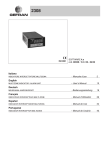
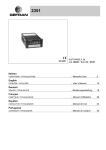


![2308 (PDF/131Ko) [F]](http://vs1.manualzilla.com/store/data/006354194_1-c5492b6e29b762ae89a93d5ab72c5466-150x150.png)
